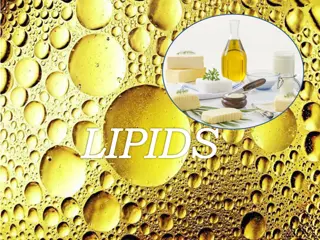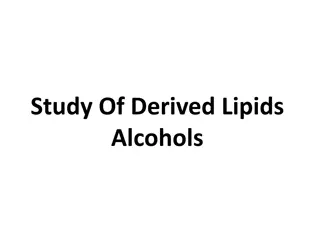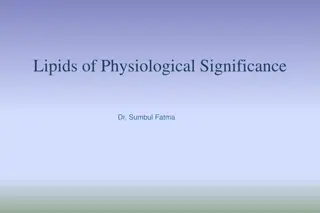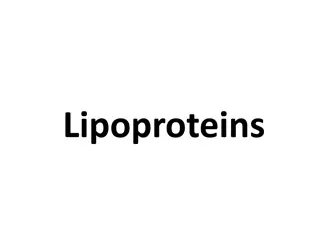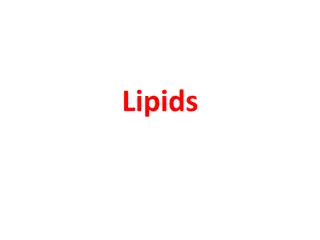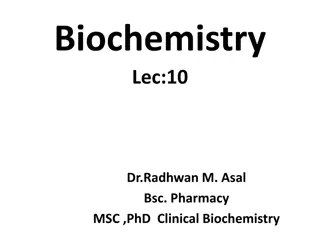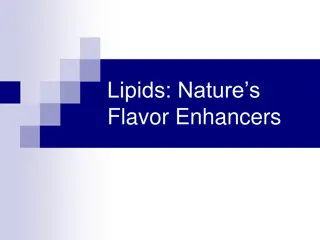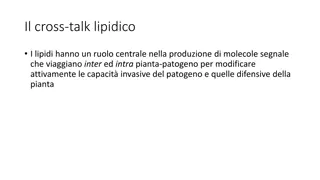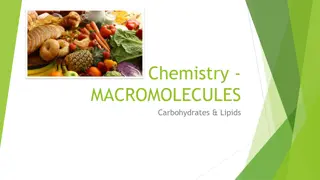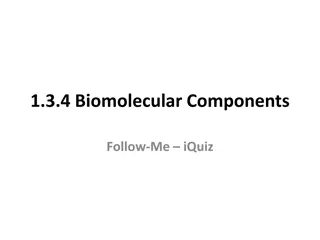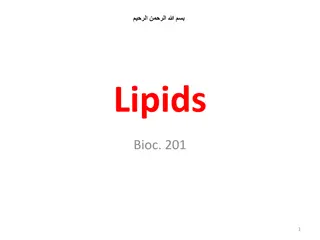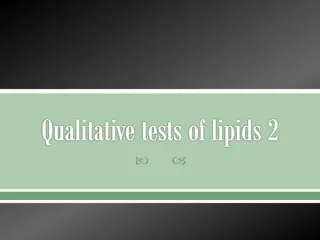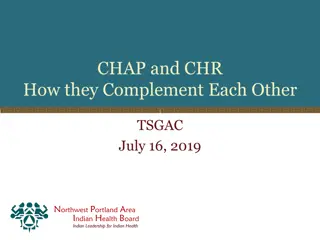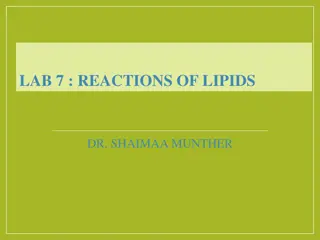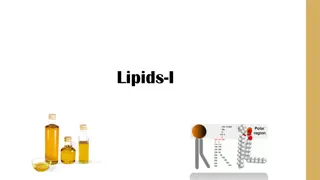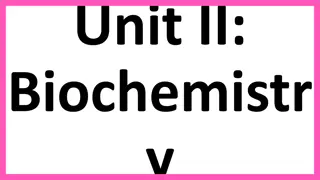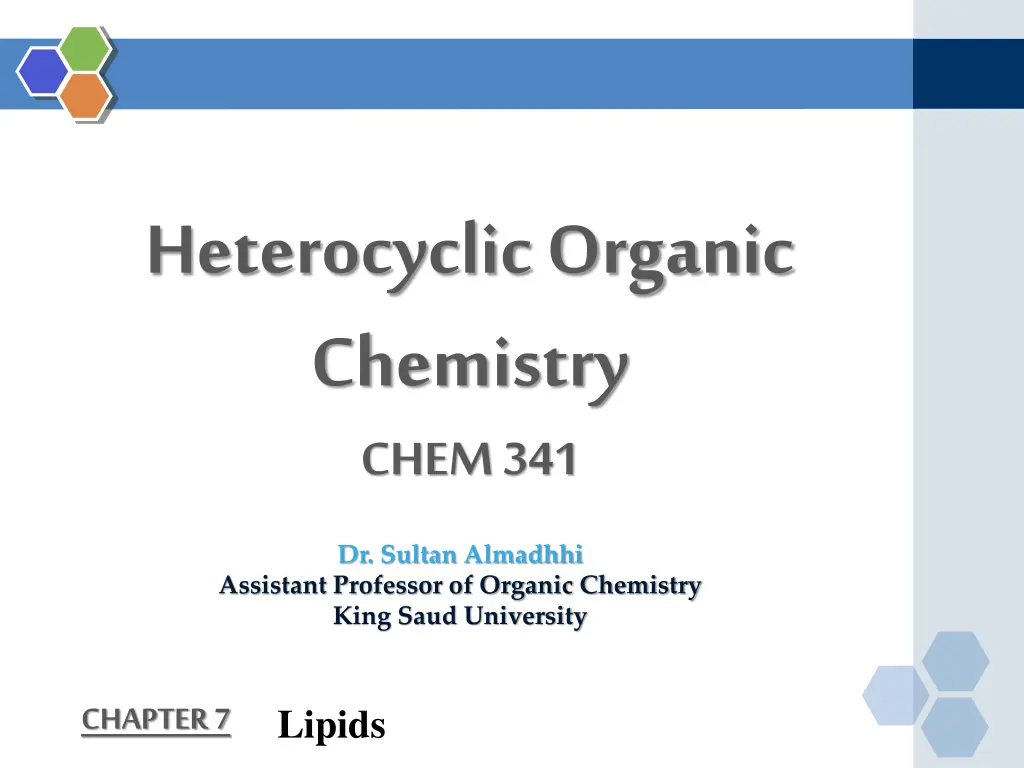
Understanding Lipids in Organic Chemistry: Chapter 7 Overview
Explore the intricate world of lipids in organic chemistry with a focus on their classification, fatty acids, and essential components. Learn about the structure, properties, and significance of lipids in plants and animals. Delve into the diverse categories of lipids, from simple to complex, saturated to unsaturated fatty acids. Unravel the role of essential fatty acids for overall health and well-being.
Download Presentation

Please find below an Image/Link to download the presentation.
The content on the website is provided AS IS for your information and personal use only. It may not be sold, licensed, or shared on other websites without obtaining consent from the author. If you encounter any issues during the download, it is possible that the publisher has removed the file from their server.
You are allowed to download the files provided on this website for personal or commercial use, subject to the condition that they are used lawfully. All files are the property of their respective owners.
The content on the website is provided AS IS for your information and personal use only. It may not be sold, licensed, or shared on other websites without obtaining consent from the author.
E N D
Presentation Transcript
Heterocyclic Organic Chemistry CHEM 341 Dr. Sultan Almadhhi Assistant Professor of Organic Chemistry King Saud University CHAPTER 7 Lipids
Introduction Lipids (from the Greek lipos, fat) are constituents of plants or animals. They are insoluble in water but are soluble in nonpolar organic solvents. They are the waxy, greasy, or oily compounds. Lipids may vary considerably in chemical structure, even though they have similar solubility properties. Some are esters and some are hydrocarbons; some are acyclic and others are cyclic, even polycyclic.
Classification of Lipids Lipids are divided into: A. Simple lipids: contain two components (fatty acid and an alcohol): Triglycerides (Fats & oils) Waxes Complex lipids: contain more than two components (fatty acids, alcohol, and other components): phosphoglycerides Sphingolipids 1) Saponifiable (Hydrolyzable) lipids They contain esters. They can undergo saponification B. (hydrolysis under basic conditions) 2) Nonsaponifiable (Nonhydrolyzable) lipids They do not contain ester groups, steroids prostaglandins They cannot be saponified (cannot be cleaved into smaller molecules by aqueous hydrolysis)
Fatty Acids Fatty acids are long-chain unbranched carbon attached to a carboxyl group (-COOH ). They are usually have straight chains (no branches) that are about 10 to 20 carbon atoms in length. They usually have an even number of carbon atoms (counting the carboxyl carbon). The carbon chains may be; saturated (all single bonds) or unsaturated (containing double bonds). Functional groups are only the carboxyl group and the double bonds. The double bonds are usually in cis configurations.
Saturated and Unsaturated Fatty Acids Saturated fatty acids have no double bonds in their long hydrocarbon chains. Stearic acid: CH3 (CH2 )16COOH (m.p. 71 C) They are solids at room temperature. It is found in palm oil, which is frequently used in handmade soap.
Saturated and Unsaturated Fatty Acids Unsaturated fatty acids have one or more double bonds (generally cis) in their long hydrocarbon chains. Oleic acid (18 carbona, one double bond) (m.p. 13 C) It is derived mainly from olive oil. sesame oil, sunflower, shea butter, coconut oil, ... etc. Linoleic acid (18 carbona, two double bonds) (m.p. -5 C) is found in soybean oil
Essential Fatty Acids Most of the fatty acids we need can be synthesized in the body. Two fatty acids, linoleic acid and linolenic acid, both polyunsaturated fatty acids with 18-carbon chains, cannot be synthesized in the body and must be obtained from the diet, These are essential fatty acids. Both are found in plant and fish oils. In the body, they are used to produce hormone-like substances that regulate blood pressure, blood clotting, blood lipid levels, the immune response, and inflammatory reactions. All fatty acids that bear the omega label are unsaturated, containing one or more double bonds.(Omega-n acids n: the position of the first double bond)
Simple lipids Fats and oils: Triglycerides Animal fats and vegetable oils are esters composed of three molecules of a fatty acid connected to a glycerol molecule, producing a structure called a triglyceride or a triacylglycerol. There are two types of triglycerides: simple triglycerides, in which all three fatty acids are identical, and mixed triglycerides.
Fats and oils: Triglycerides Fats are: triglycerides that are solids at room temp. usually derived from animals. mostly saturated fatty acids. Oils are: triglycerides that are liquids at room temp. usually derived from plants or fish. mostly unsaturated fatty acids.
Chemical Properties of Fats and Oils Hydrolysis of Triglycerides: Triglycerides can be broken apart with water and an acid catalyst (hydrolysis), or by digestive enzymes called lipases. Saponification of Triglycerides (Basic Hydrolysis): Triglycerides react with strong bases (NaOH or KOH) to form the carboxylate salts of the fatty acids, called soaps:
Chemical Properties of Fats and Oils Hydrogenation: Vegetable oils, which are highly unsaturated, are converted into solid vegetable fats by catalytically hydrogenating some or all of the double bonds.
Simple lipids Waxes Waxes differ from fats and oils in that they are simple monoesters. The acid and alcohol portions of a wax molecule both have long saturated carbon chains. Waxes are insoluble in water, and not as easily hydrolyzed as fats and oils. Waxes often occur in nature as protective coatings on feathers, fur, skin, leaves, and fruits. Waxes are used commercially to make cosmetics, candles, ointments, and protective polishes.
Complex lipids Phospholipids Phospholipids are related structurally to fats and oils, except that one of the three ester groups is replaced by a phosphatidylamine. There are two common types: Phosphoglycerol and Sphingolipids Phosphoglycerol Phosphoglycerols are complex lipids that are major components of cell membranes. Structurally, they resemble a triacylglycerol, except the third fatty acid has been replaced with a phosphodiester bonded to an alcohol.
Phospholipids There are two types of phosphoglycerols: 1) Cephalins are found in most cell membranes, particularly abundant in brain tissue, found in blood platelets and play a role in blood clotting. 2) Lecithin can act as an emulsifying agent: important structural component of cell membranes, play a role in the transport of lipids in the blood stream. Commercially, lecithin extracted from soybeans is used as an emulsifying agent in margarine and candies to provide a smooth texture.
Phospholipids Sphingolipids Sphingolipids are complex lipids that contain sphingosine instead of glycerol. They do not contain an ester; their single fatty acid is bonded to the backbone by an amide bond They are found brain and nerve tissue, and in the myelin sheath that protects nerves.
Phospholipids Glycolipids Glycolipids are sphingolipids that contain carbohydrates (usually monosaccharides). They are also referred to as cerebrosides because of their abundance in brain tissue.
Steroids Steroids are classified as lipids because they are soluble in nonpolar solvents. They are nonsaponifiable because the components are not held together by ester linkages. The basic steroid structure contains four fused rings: Usually there are methyl substituents attached to C-10 and C-13 (called angular methyl groups) and some sort of side chain attached to C-17. The best known steroid is cholesterol, bile salts, sex hormones and vitamin D.
Steroids Cholesterol Cholesterol is an essential component of cell membranes. There is apparently a correlation between high levels of cholesterol in the blood and atherosclerosis. Cholesterol is obtained from meats, milk, and eggs. Cholesterol is synthesized in the liver from fats, carbohydrates and proteins. No cholesterol in vegetable and plants.
Steroids Bile Salts Bile is a yellowish brown or green fluid produced in the liver and stored in the gallbladder. Bile salts act like soaps and other emulsifiers: they contain both polar and nonpolar regions, helping to break fats in foods into smaller pieces, allowing them to be hydrolyzed more easily.
Steroids Steroid Hormones A hormone is a molecule that is synthesized in one part of an organism, which then elicits a response at a different site. Two types of steroids hormones: 1. Sex hormones Estrogens & progestins in females Androgens in males 2. Adrenal Cortical Steroids Estrogens: Estradiol and Estrone control development of secondary sex characteristics.
Steroids Progestins : Progesterone is called the pregnancy hormone . Androgens: Testosterone and Androsterone control the development of secondary sex characteristics in males.
Steroids Adrenocorticoid hormones They are produced in the adrenal glands (located on the top of the kidney). Glucocorticoids such as cortisol affect the metabolism of carbohydrates. Cortisol and its derivatives, cortisone and prednisolone (synthetic) are powerful anti-inflammatory drugs used to treat arthritis and asthma.
Steroids Vitamin D It can be synthesized from cholesterol. It can be obtained in the diet from many foods, especially milk, and helps regulate Ca and P metabolism. A deficiency of vitamin D causes rickets (bone malformation).
Prostaglandins Prostaglandins are carboxylic acids that contain a five-membered ring and have a wide range of biological activities. Prostaglandins are responsible for inflammation. They also decrease gastric secretions, inhibit blood platelet aggregation, stimulate uterine contractions, and relax smooth muscles.

